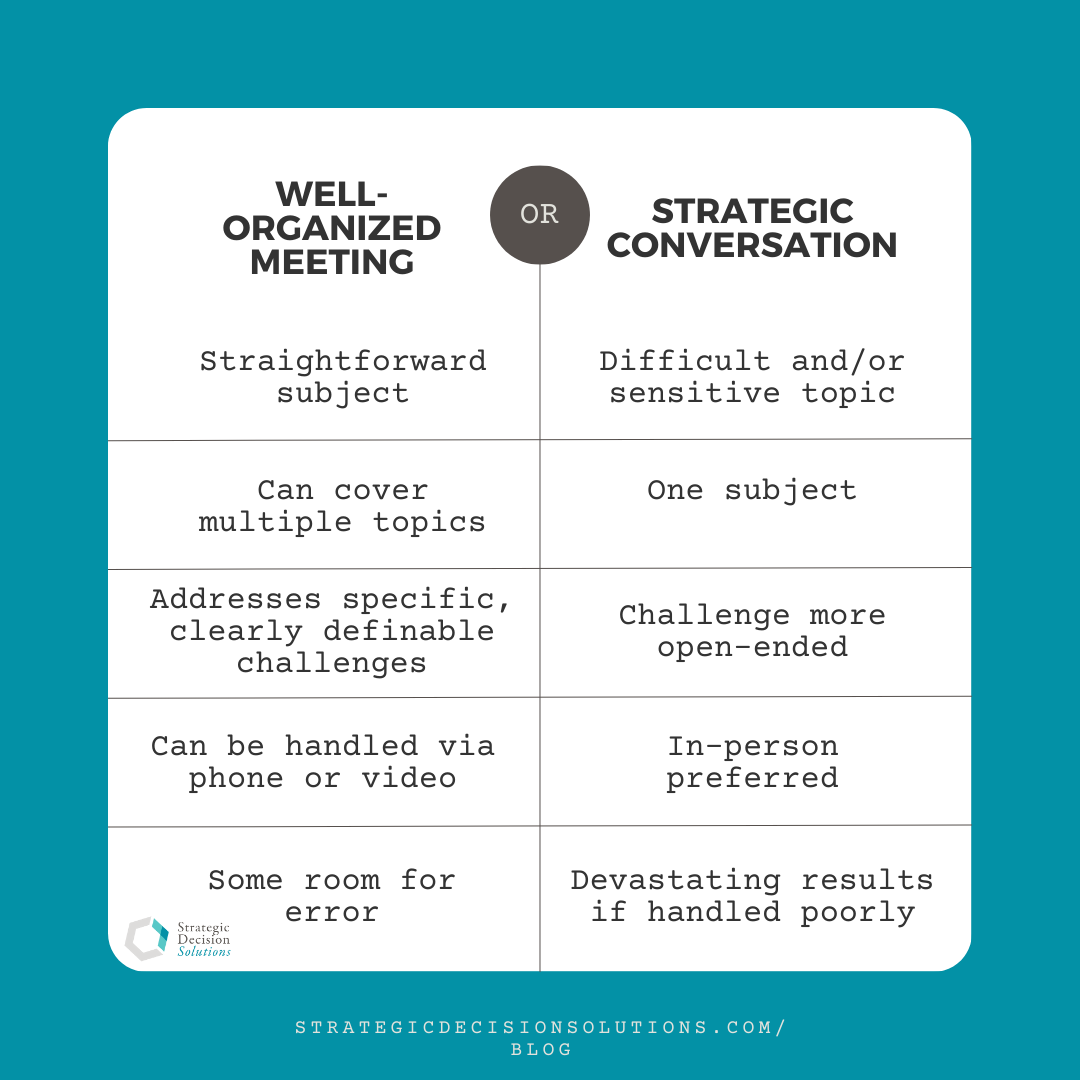This topic is part of the larger idea of soft skills (previously discussed in other articles – see here, here and here), which is the crucial component of being an effective risk professional far beyond technical processes or which ERM software you use. After all, if a particular assessment approach falls short, you can check that off the list and try again. However, if a delicate conversation with an executive goes poorly, it could set ERM back significantly.
There may not seem to be much of a difference between a well-organized meeting and a strategic conversation on the surface, and in some respects, that is true.
A strategic conversation includes all the basics of a well-organized meeting, like a clear purpose, the right participant(s), and the right environment or venue to ensure a good outcome.
The standard meeting is for just that – standard things with clearly definable objectives involving a subject that’s straightforward. They usually have multiple participants, and when organized and managed well, can cover a wide-range of subjects in a short amount of time.
A prime example of this is a project kick-off meeting to figure out logistics and timing, review/confirm the project scope, and make sure everyone is on the same page.
When time is taken to prepare an agenda (with talking notes for yourself) and determine who should attend and/or participate, meetings like this can be extremely productive. And while meetings should be something you should prepare for, it isn’t the end of the world if it doesn’t quite turn out how you planned. (That’s why good risk practitioners must be agile and adaptable.)
That’s not to say you shouldn’t prepare as best as you can.
For example, if it’s a status call with an external vendor, you should carefully review what you last spoke about so you don’t ask the same questions again and appear clueless.
A well-organized meeting should end with a clear idea of next steps, roles, and responsibilities.
While a strategic conversation should cover all the basics of a well-organized meeting, the subject involves a much more difficult or sensitive subject.
Unlike a meeting, a strategic conversation can be shorter and limited to one very specific subject that is a big deal. After all, Oxford’s definition of “strategic” is “carefully designed or planned to serve a particular purpose or advantage.”
In a meeting, the challenge and end goal are very specific. On the other hand, a strategic conversation should tackle a more open-ended, delicate challenge. As Chris Ertel and Lisa Kay Solomon explain in their book Moments of Impact: How to Design Strategic Conversations that Accelerate Change:
The job is not to find the right answer to an adaptive challenge but rather to help shape people’s perceptions of the problem, and thus, of potential solutions.
To do this, the bigger picture and how the subject fits into it (i.e., context) must be understood ahead of time…which means you must perform some research and do your homework before the strategic conversation.
Since the subject is often emotionally charged, understanding the personalities and preferences of each participant, as well as any relevant history beforehand, is critical to a successful outcome. You also want to understand what is important to the participant(s), so you can approach the topic in a way that will produce the right outcome.
In light of the delicate, emotional nature of these conversations, they should be done in-person if at all possible. Video conferencing is an acceptable alternative if in-person isn’t feasible, but these conversations should absolutely NOT be done over the phone, as you will not be able to see facial expressions and body language.
Also, careful consideration has to be given to timing. Although the other person(s) may be available on the calendar, that person may not be truly available (a/k/a in a good place mentally or emotionally) to have a strategic conversation. If they’re having a rough day or just coming off annual Board meetings, you will want to reconsider your timing as any sensitive subject will not be received well.

Having a strategic conversation isn’t a skill most business schools teach (…but should!).
Having a strategic conversation is something we do unconsciously in both our personal and professional lives.
For instance, my husband recently had to have a difficult conversation on an emotional family matter. Understanding the thoughts and emotions of his cousin prior to the conversation enabled him to be prepared with the right words and tone, which helped move the situation to the best possible conclusion.
Let’s examine a difficult strategic conversation that I needed to have with a client.
Before engaging me, the company was losing money in a particularly turbulent industry.
After my initial evaluation and observation, I determined the then-COO was one of the primary drivers of the company’s woes. The difficulty was this person had been with the company for over a decade, and to add insult to injury, was a personal friend of the CEO, who does NOT like negative confrontational conversations.
This was definitely a challenge, but I did know the CEO was planning to eventually retire and have his daughter assume the CEO position. The company was his other child, and he wanted nothing more than for his daughter to be a successful executive of a successful company.
After some brainstorming and gaining a better understanding of the background nuances, I was able to persuade the CEO that he needed to find a new COO if he wanted the company to return to profitability and set his daughter up for success. Two key elements of that persuasion were giving him alternative outcomes (good and ugly), and a couple ways he could go about achieving the good outcome. He chose the good outcome, and the company management has worked hard to change and mature.
There’s a common misconception that a “strategic conversation” is only for strategic planning, but as this situation illustrates, nothing could be further from the truth. The reality is that a strategic conversation is when you need to have a conversation about a sensitive topic, and you need to be strategic about your approach, thinking, planning, and execution of that conversation.
Understanding the differences between a well-organized meeting and a strategic conversation will enable you to effectively conduct each one. Also, being able to tackle a difficult strategic conversation is one thing that separates great ERM professionals from the adequate ones.
Have you noticed the difference between a regular meeting and strategic conversation at your company? Has this understanding enabled you to handle each more effectively?
Please don’t hesitate to share your perspective in the comments field below.
Reach out to me via email if you’ve been struggling to have a strategic conversation that produces valuable insights, and we can figure out a potential path to move you forward.








